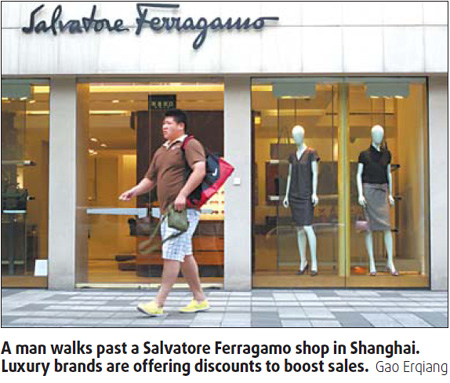
Luxury brands are now in the same boat as many others and are wooing customers by reducing prices amid the global economic downturn. So much so even big marquee names like Louis Vuitton are also dropping prices.
Since late last month, more than half of over 110 top fashion brands in the Plaza 66, a high-end shopping mall in Shanghai, have started sales promotions to offload their stocks.
Louis Vuitton, for instance, has marked down prices of some of its products by 100 to 200 yuan, a sales assistant in its boutique told China Daily. She said the price change was more in line with currency fluctuations, rather than discounts.
"These brands may have opted for price cuts to try to stem sales declines as spending on luxury items may have been curtailed," said Andrew Darryl, CEO of business consulting firm Synovate, adding that Chinese customers may not be as flush with funds due to eroded capital gains and mounting job security concerns.
Other premier brands like Gucci, Salvatore Ferragamo, and Dunhill are also cutting prices to boost sales.
At the Gucci store in the Shanghai Times Square, over 20 different handbags were on the shelf marked with discrete sales tags.
According to the shop's sales assistant, most of these products have been marked down 30 percent from their normal prices. Some of them were on sale at a 50-percent discount.
"We have seen more customer flows recently, and the handbags with 50 percent discounts have been nearly sold out," the assistant said.
"Most of the female colleagues in my office decided to come to the store for bargain products on hearing the discount news," said Shi Lin from American International Assurance Company's Shanghai branch, after finishing shopping at the Gucci store.
But she said most of the discounted items are out-of-season products, while prices of classic products are still unchanged. "At least, we can save flight tickets to Hong Kong, and buy a discounted product right at our doorstep, even if it is not new arrival," she said.
Zhang Qiang, general manager of FoxTown Outlet China in Shanghai, has also perceived the changes when purchasing products of some high-end brands like Escada, Armani and Versace. In the past, his purchases were largely dictated by the availability of these name-brand goods. "Now, I have a much bigger selection to choose from," Zhang said.
Escada, for instance, provided this spring/summer selection for FoxTown this year, said Zhang. "In the past, they only provide the spring or last winter's selection for us. Their inventory pressure is obvious."
Indeed, for most high-end brands, China has become the panacea for bleeding sales in the West. A recent report compiled by public relation agency Ruder Finn showed that sales of luxury goods in China totaled $8.6 billion yuan from the beginning of 2008 to this January, accounting for 25 percent of the global market share. In contrast the sales growth rate in Europe nearly halved last year.
China Brand Strategy Association estimated in a recent research report that the number of people purchasing luxury brands may touch 250 million by 2010.
Most of the top brands have cut prices to meet increasing customer demands, to trim the price gap between China and other regions and to entice customers, Zhang said.
Even though the price cuts have dragged down the top brands from their iconic status, most consumers still believe their value is sustainable
"Gucci is still Gucci, the discounts are still small when compared with other affordable luxury products or mid-end products," Shi said.
It is unlikely that a price reduction will tarnish top brands' established image, said Synovate's Darryl. "It is interesting to see how stores in Hong Kong thrive on sales of second-hand Louis Vuitton and Gucci bags. Even when they are used, consumers still ascribe considerable value to the brand and its products," he said.
(China Daily July 25, 2009)